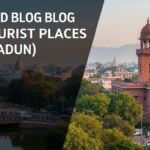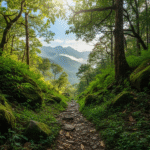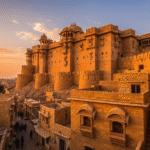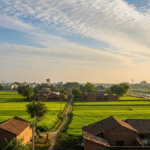Every year, thousands of adventurers are drawn to India’s stunning wonders. Many do not know that hidden in the mountains are mysterious lakes. These lakes offer peace and a challenge to those who find them. The unspoiled nature and ancient stories call out to brave explorers. They invite people to a unique exploration of Indian lakes.
There’s a dark side to their beauty too. Over 5,000 people were lost to the Kedarnath floods in 2013, caused by Chorabari Lake breaking. This shows the beauty and danger of these secluded spots. Despite the risks, people hike for days to reach lakes like Marinda Tal. The journey is as important as the destination. It takes you through India’s ancient landscapes.
India’s hidden lakes continue to draw in those looking for beauty. Alpine lakes, located high up, are fed by old glaciers. They mirror the sky with their clear waters. Their untouched state makes the visit deeply moving. These lakes have stories and offer peace far from our busy world.
Key Takeaways
- India boasts a wealth of hidden lakes, each with its own lore and geologic splendor.
- The journey to these lakes involves treks through some of the most breathtaking and unspoiled landscapes in India.
- Alpine lakes’ clarity and color are natural wonders, offering a unique and tranquil explorer’s experience.
- Visiting these lakes requires careful timing to witness their beauty, varying across seasons.
- Preservation of these pristine environments is paramount, seeing as they form part of India’s rich natural heritage.
The Alluring Enigma of Sattal’s Seven Lakes
Sattal lies in the peaceful foothills of the Himalayas in Uttarakhand. It is a beautiful complex of seven interconnected freshwater lakes. Each lake has its own story of myth and nature, surrounded by thick oak and pine forests. This makes it a heaven for people who love nature and the outdoors.
The lakes have names like Purna Tal, Laxman Tal, Sita Tal, Sukha Tal, and Garud Tal. There are two others too. They are important for the area’s ecology and culture. Their names come from ancient Indian stories. This makes the Sattal lakes in Uttarakhand even more special.
Sattal is a place full of life, with about 500 kinds of birds. It’s perfect for people who love to watch birds or study them. The weather and water there are great for plants and animals to thrive. It’s one of India’s hidden gems.
Sattal is great for all kinds of fun activities. You can go kayaking, climb rocks, watch birds, or just take walks in nature. It’s easy to get there from big cities. There’s a railway station nearby. This makes it a perfect spot for a peaceful break from city life.
| Feature | Details |
|---|---|
| Elevation | 1370 meters above sea level |
| Number of Lakes | Seven interconnected lakes |
| Flora and Fauna | Over 500 species of birds, 525 varieties of butterflies |
| Accessibility | 33 km from Kathgodam railway station, well-connected by roads |
| Activities | Bird watching, Trekking, Boating, Rock Climbing |
| Climate | Temperate, 15-30°C in summer, down to -10°C in winter |
For those wanting to relax in nature, Sattal is perfect. You can explore green trails, see beautiful birds, or relax by the lakes. It offers a calm retreat in one of India’s most beautiful hidden lakes.
Mysterious lakes in India: Unraveling Roopkund’s Skeleton Mystery
India has many mysterious lakes, but Roopkund stands out. It’s high in the Himalayas. Every year, as ice melts, it shows hundreds of human skeletons. This surprises historians and scientists.
The chilling discovery of Skeleton Lake
In 1942, a British guard found skeletons at Roopkund Lake. Many theories tried to explain this. It’s way up at 16,500 feet. Now, science shows it’s not just one event but many over time.
Genetic revelations and historical analysis
Recent studies gave new info about Roopkund. They found different genetic groups among the skeletons. A 2019 study showed they died at different times. This challenges old thoughts of a single disaster.
| Genetic Group | Origin | Estimated Time of Death |
|---|---|---|
| Group 1 | South Asian | 7th-10th Century |
| Group 2 | East Asian | 17th-20th Century |
| Group 3 | Eastern Mediterranean | 17th-20th Century |
This tells us more than just history. It shows ancient migration and trade. It hints at unknown stories of different peoples. Roopkund Lake keeps offering clues about India’s past.
Illuminating the Sacred and Inscrutable Parashar Lake
Parashar Lake sits high up in Himachal Pradesh near Mandi. It is a sacred lake in India wrapped in mystery. Stories say sage Parashar gives the lake its name. According to legend, Bhima formed the lake with his elbow during their way back from Kurukshetra. There’s also a floating island in the lake. It moves around by unknown forces.
The lake is stunning and holy. Here, boats are not allowed to keep the place pure. Scientists and pilgrims are drawn here, yet its depth remains a secret. Even with tools, no one can find the bottom. Interestingly, it’s warm and its water level doesn’t change, which confuses experts.
Parashar Lake links myths with nature’s wonders. It’s more than pretty views—it connects us to India’s past and spirituality.
Research connects lake legends with ancient texts. These stories show India’s deep cultural past. They also teach us important lessons today.
| Feature | Description |
|---|---|
| Geographic Location | Near Mandi, Himachal Pradesh, India |
| Mythological Importance | Named after sage Parashar; believed to be created by Bhima’s elbow |
| Unique Physical Feature | Floating island that changes position |
| Unexplored Depth | Attempts to measure depth unsuccessful |
| Temperature & Water Level | Constant warm temperature and stable water level year-round |
Parashar Lake adds to sacred lakes in India. It attracts those curious about nature and old tales. This site invites seekers to explore stories and wonders that have been in India, or Aryavarta, for ages.
The Enigmatic Charm of India’s Hidden Lakes
The allure of India’s hidden lakes is breathtaking and mysterious. They are not just pretty sights. They hold unexplained wonders and ancient secrets. Discovering these lakes means exploring beautiful landscapes and uncovering secrets.
Hidden jewels of the Indian terrain
Urgos Lake in Himachal Pradesh is a quiet beauty among rugged lands. It is often missed by travelers. Roopkund Lake, at a high altitude, holds human bones telling ancient stories. Lakes like Roopkund puzzle both historians and tourists with their stories.
Why these lakes remain a secret
These lakes stay hidden because of where they are located. Suraj Tal Lake, for example, is high up and hard to get to. It’s kept isolated by weather and its sacredness to locals. These special places are untouched and full of mystery.
New paths, like the Manali – Darcha – Shinkula pass, may make these lakes easier to reach. Yet, their beauty and stories remain special for those who go the distance to see them.
Discovering Eerie Lakes of India Through Local Myths and Legends
The eerie lakes of India are full of myths and stories. Among them, Roopkund Lake is very special because of its secrets and links to mythology. This makes it a prime spot for exploring mythological lakes. Roopkund is also called Skeleton Lake because over 300 skeletons are found there. This raises many questions and has created lots of legends.
Stories about Roopkund talk of sudden huge hailstorms that killed many pilgrims long ago. These tales are a big part of the eerie lakes of India. They mix nature and supernatural beliefs together. The stories are kept alive through cultural festivals and pilgrimages like the Nanda Devi Raj Jat.
Roopkund is not just for legend lovers but also attracts hikers. Even though it’s hard to reach and has tough weather, the lake is a must-see. Here, history and legend meet in an amazing way through Indian Lakes folklore.
These eerie lakes of India are deeply connected to local culture and beliefs. The government tries to protect Roopkund from too much tourism and harm. This shows how we balance keeping the lake safe and exploring it.
Lakes like Roopkund are more than just water; they hold history and mystery. They invite us to see what’s beneath the surface. These lakes make us think about the spiritual and historical stories of India.
Beneath the Surface: The Unexplained Phenomena of Indian Lakes
India has many lakes with deep mysteries. They catch the eye of both researchers and tourists. Mysterious floating islands and warm lakes are especially puzzling. They push the limits of science and spark our dreams.
The peculiar case of floating islands
Some lakes have islands that float and move on their own. These islands are made of plants and soil. They move with the unseen currents below. Their unpredictable journey puzzles scientists and inspires local legends. The island in Parashar Lake even spins around the water, moved by unseen forces.
Lakes with inexplicable temperature levels
Some Indian lakes stay warm even in cold winters, which is strange. They don’t sit over volcanic areas, which usually explain warmth. This puzzle is great for both scientists and storytellers.
Studying these lakes often leaves us with more questions. Lake Lonar in Maharashtra is one such mystery. It has unusual features that even interest NASA. You can read about it at The Times of India.

These lakes are more than just water. They support life and are part of local stories and traditions. Their secrets and beauty attract those who love mysteries. They also offer chances for tourism that respects and keeps their magic for the future.
The Mystical Experiences at India’s Secret Lakes
India has mysterious lake adventures that go beyond normal travel. Visitors explore spiritual lake experiences. They touch on India’s culture and nature. These Indian lakes are not just water bodies, but places of peace and mystery. They have special stories and mean a lot spiritually, calling to eager travelers.
Sanglaphu Lake in Sikkim is really high up, at 16,670 feet. About 150 km west of Gangtok, it’s a sight to see. It’s also a spiritual place for visits in May, June, and October.
This lake is sacred in Sikkim, linked to local gods and old tales. It gives a deep spiritual feeling to those who visit.
Chandra Taal in Himachal Pradesh, or ‘moon lake,’ is another hidden gem. Its clear glacial waters and desert surroundings are stunning. Chandra Taal shows the untouched beauty of India’s mysterious lakes.
In the north, Gurudongmar Lake sits tall at 17,100 feet. A story with Guru Nanak makes this lake sacred. It has a special spot of water that doesn’t freeze, believed to be a miracle. These tales add to the lakes’ mystical charm, tying nature and spirituality together.
To really enjoy these places, we have to travel responsibly. We should use green transport, not trash the place, and respect local ways. This helps keep the sites pure and respected by visitors.
Going to these mystical Indian lakes is very rewarding. You get to see amazing places, feel spiritual, and have an adventure. Indeed, these trips give memories that stick with you forever.
The Biodiversity of Mystical Indian Lakes and Their Conservation
The lush landscapes and mystical lakes of India are a sanctuary for humans and wildlife. They are vital ecosystems supporting over 2,000 species of fish, 140 amphibians, and about 90 reptiles. The Indian lake biodiversity is rich and varied, hosting crucial migratory bird sanctuaries.
Home to rare species and migratory birds
The Ganges River Dolphin, India’s National aquatic animal, lives in these waters. Only about 2,000 remain. These lakes help feed and breed local species and migratory birds. A part of Loktak Lake is now a “Bird Sanctuary” for these birds in winter.
Efforts in preservation and ecological importance
The conservation of mystical lakes is crucial due to habitat loss and climate change. Inventories, protection policies, and community efforts help preserve these habitats. Policy documents on sacred groves and ponds show how culture and conservation connect.

| Species | Population | Conservation Status |
|---|---|---|
| Ganges River Dolphin | Approx. 2,000 | Endangered |
| Golden Mahseer | Declining due to over-fishing | At risk |
| Loktak Lake Migratory Birds | Declining | Protected (Bird Sanctuary) |
These aquatic systems are ecologically and culturally significant. With ongoing conservation efforts, these lakes can continue to support wildlife and communities for generations.
Traveler’s Guide to India’s Most Enigmatic Lakes
Are you drawn to India’s mysterious waters? You’ll need an Indian lakes travel guide. Taking tours of these mysterious lakes is a special chance to see their calm beauty. It’s perfect whether you’re a seasoned traveler or visiting for the first time. Knowing the best times to go and which ways to take will make your trip better.
Best times and routes for an unforgettable journey
Visit these high lakes from April to June and September to December. This way, you avoid the cold winter and rainy seasons. For example, late spring or early autumn is great for visiting Sikkim’s Gurudongmar Lake. This time offers the best weather for a rewarding trek. Similarly, Roopkund Lake, with its mysterious bones, is easier to reach during these months.
Tips for exploring India’s mysterious lakes responsibly
Exploring these lakes without harming them is important. Follow the trails, take your trash, and respect the animals and plants. Some lakes, like Sikkim’s Tsomgo Lake, are sacred to locals. Using local guides not only makes your trip richer but also helps local people and keeps tourism sustainable.
Each lake, from Pangong’s vast waters to the sacred, ever-changing Tsomgo Lake, has its own story. Here’s a quick look at some key high lakes in India. It includes their heights and special features to help plan your visit.
| Lake Name | Altitude (feet) | Special Attributes |
|---|---|---|
| Gurudongmar Lake | 17,800 | One of the highest lakes in India, located in Sikkim |
| Tso Moriri | 14,836 | Spans 26 km in length, hosts diverse wildlife |
| Pangong Lake | 13,862 | Extends over three countries, featured in popular culture |
| Roopkund Lake | 14,882 | Known as Skeleton Lake due to the human remains found |
| Chandra Tal | 14,100 | Crescent-shaped, significant in Hindu mythology |
Eco-tourism and the Stewardship of India’s Enigmatic Lakes
Eco-tourism in India has become very popular. It’s all about loving the beautiful outdoors and saving it for our children. Places like Uttarakhand’s Roopkund, also known as Skeleton Lake, teach us to care about nature. Here, tourists learn to leave only footprints and help keep the lake clean.
Working with local communities is key to sustainable lake visits. These communities share their wisdom, helping save the lakes. When tourists follow their lead, everyone can enjoy nature without causing harm. This way, we make sure these places stay beautiful.
| Feature | Impact |
|---|---|
| Regulated Trekking Paths | Preserves natural terrain and prevents erosion |
| Limited Visitor Quotas | Controls foot traffic and environmental strain |
| Eco-Friendly Waste Management | Reduces litter and pollution in the lake area |
| Community Involvement | Empowers local stewardship and monitors lake health |
The Chipko Movement and the Bishnoi’s love for nature teach us a lot. These stories from India show how people have always protected their environment. Today, they inspire us to keep lakes safe and clean.
Choosing sustainable lake visits means tourists help save beautiful places. Visiting lakes like Roopkund responsibly protects them. It keeps them full of life and history for all to see.
Conclusion
Traveling through India’s lakes is like reading a book full of stories. Each lake in India has a story. Looks like Roopkund tell tales from the 9th century. They talk about old mysteries and the many lives that came before us.
These lakes are high up, like over 16,000 feet above where seas stay. But they are not just places on a map. They keep history safe, showing how people and nature worked together long ago. Keeping these lakes safe is key. It helps keep their stories and lessons for the future.
We’ve seen so much on our journey, from mysteries to all kinds of life. These lakes bring together science and faith, showing India’s heart. They call out to everyone to come see their beauty and to help look after them. By trying to understand and protect them, these lakes prove how amazing nature and our love for mysteries are.
FAQ
What are some of the mysterious lakes in India?
India has mysterious lakes like Roopkund, also known as Skeleton Lake. There’s also Parashar Lake with a floating island, and the Sattal lakes cluster. They’re famous for their mysteries and legends.
Why is Roopkund Lake known as Skeleton Lake?
Roopkund Lake got its name because of many human skeletons found at its bottom. When the ice melts, these skeletons become visible. They have sparked many studies and guesses.
What is the legend associated with Parashar Lake?
Legend says Parashar Lake formed from Bhima’s elbow dent, a hero in the Mahabharata. It’s named after sage Parashar and is a holy place.
Are there any scientific explanations for the phenomena observed in India’s mysterious lakes?
Scientists study these lakes, trying to explain their mysteries. For example, genetic research sheds light on Roopkund Lake’s skeletons. But, mysteries like Parashar’s floating island remain unexplained scientifically.
Can visitors swim in the mystical lakes of India?
Swimming rules differ by lake. Sacred lakes, like Parashar, forbid swimming to keep them pure. Always check local rules and respect them.
How can tourists responsibly explore India’s hidden lakes?
To explore responsibly, follow eco-tourism practices. These include little environmental impact and not littering. Also, respect wildlife and local cultures while helping in conservation.
What is the ecological importance of these mystical Indian lakes?
These lakes are crucial for biodiversity, offering homes to rare species and a rest for migratory birds. They help keep ecological balance and beautify their regions.
When is the best time to visit the Sattal lakes in Uttarakhand?
The best visit times are April to June and September to December. The weather is great, and the lakes’ beauty shines the most then.
What is eco-tourism and how does it relate to India’s enigmatic lakes?
Eco-tourism means traveling that helps conservation and local communities, educating about the environment. It fits well with India’s mysterious lakes by limiting impact and encouraging enjoyment and appreciation.
What steps are being taken to preserve the natural state of India’s mysterious lakes?
Efforts to keep the lakes natural include protecting habitats, controlling pollution, and managing tourism. Researchers, environmentalists, the government, and locals work together for sustainable visits.










